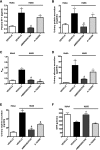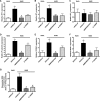Long-Term Endothelin-A Receptor Antagonism Provides Robust Renal Protection in Humanized Sickle Cell Disease Mice
- PMID: 28348063
- PMCID: PMC5533228
- DOI: 10.1681/ASN.2016070711
Long-Term Endothelin-A Receptor Antagonism Provides Robust Renal Protection in Humanized Sickle Cell Disease Mice
Abstract
Sickle cell disease (SCD)-associated nephropathy is a major source of morbidity and mortality in patients because of the lack of efficacious treatments targeting renal manifestations of the disease. Here, we describe a long-term treatment strategy with the selective endothelin-A receptor (ETA) antagonist, ambrisentan, designed to interfere with the development of nephropathy in a humanized mouse model of SCD. Ambrisentan preserved GFR at the level of nondisease controls and prevented the development of proteinuria, albuminuria, and nephrinuria. Microscopy studies demonstrated prevention of podocyte loss and structural alterations, the absence of vascular congestion, and attenuation of glomerulosclerosis in treated mice. Studies in isolated glomeruli showed that treatment reduced inflammation and oxidative stress. At the level of renal tubules, ambrisentan treatment prevented the increased excretion of urinary tubular injury biomarkers. Additionally, the treatment strategy prevented tubular brush border loss, diminished tubular iron deposition, blocked the development of interstitial fibrosis, and prevented immune cell infiltration. Furthermore, the prevention of albuminuria in treated mice was associated with preservation of cortical megalin expression. In a separate series of identical experiments, combined ETA and ETB receptor antagonism provided only some of the protection observed with ambrisentan, highlighting the importance of exclusively targeting the ETA receptor in SCD. Our results demonstrate that ambrisentan treatment provides robust protection from diverse renal pathologies in SCD mice, and suggest that long-term ETA receptor antagonism may provide a strategy for the prevention of renal complications of SCD.
Keywords: endothelin; glomerular filtration barrier; proteinuria; renal injury; sickle nephropathy.
Copyright © 2017 by the American Society of Nephrology.
Figures







Comment in
-
Endothelin-A Receptor Antagonism Retards the Progression of Murine Sickle Cell Nephropathy.J Am Soc Nephrol. 2017 Aug;28(8):2253-2255. doi: 10.1681/ASN.2017030320. Epub 2017 Apr 25. J Am Soc Nephrol. 2017. PMID: 28442492 Free PMC article. No abstract available.
Similar articles
-
Combined hydroxyurea and ETA receptor blockade reduces renal injury in the humanized sickle cell mouse.Acta Physiol (Oxf). 2019 Feb;225(2):e13178. doi: 10.1111/apha.13178. Epub 2018 Sep 20. Acta Physiol (Oxf). 2019. PMID: 30144292 Free PMC article.
-
Endothelin A receptor antagonist attenuated renal iron accumulation in iron overload heme oxygenase-1 knockout mice.Can J Physiol Pharmacol. 2022 Jul 1;100(7):637-650. doi: 10.1139/cjpp-2022-0038. Epub 2022 Apr 12. Can J Physiol Pharmacol. 2022. PMID: 35413222 Free PMC article.
-
Enhanced vasoconstriction in sickle cell disease is dependent on ETA receptor activation.Clin Sci (Lond). 2024 Dec 4;138(23):1505-1520. doi: 10.1042/CS20240625. Clin Sci (Lond). 2024. PMID: 39526571 Clinical Trial.
-
Ambrisentan, an endothelin receptor type A-selective endothelin receptor antagonist, for the treatment of pulmonary arterial hypertension.Expert Opin Pharmacother. 2009 Aug;10(11):1847-58. doi: 10.1517/14656560903061275. Expert Opin Pharmacother. 2009. PMID: 19601701 Review.
-
Ambrisentan.Drugs. 2008;68(15):2195-204. doi: 10.2165/00003495-200868150-00008. Drugs. 2008. PMID: 18840007 Review.
Cited by
-
Development and characterization of a preclinical total marrow irradiation conditioning-based bone marrow transplant model for sickle cell disease.Front Oncol. 2022 Sep 6;12:969429. doi: 10.3389/fonc.2022.969429. eCollection 2022. Front Oncol. 2022. PMID: 36147914 Free PMC article.
-
ETA receptor activation contributes to T cell accumulation in the kidney following ischemia-reperfusion injury.Physiol Rep. 2018 Sep;6(17):e13865. doi: 10.14814/phy2.13865. Physiol Rep. 2018. PMID: 30198212 Free PMC article.
-
Endothelin-targeted new treatments for proteinuric and inflammatory glomerular diseases: focus on the added value to anti-renin-angiotensin system inhibition.Pediatr Nephrol. 2021 Apr;36(4):763-775. doi: 10.1007/s00467-020-04518-2. Epub 2020 Mar 17. Pediatr Nephrol. 2021. PMID: 32185491 Review.
-
Sickle Cell Disease and CKD: An Update.Am J Nephrol. 2024;55(1):56-71. doi: 10.1159/000534865. Epub 2023 Oct 27. Am J Nephrol. 2024. PMID: 37899028 Free PMC article. Review.
-
High molecular weight kininogen contributes to early mortality and kidney dysfunction in a mouse model of sickle cell disease.J Thromb Haemost. 2020 Sep;18(9):2329-2340. doi: 10.1111/jth.14972. Epub 2020 Aug 27. J Thromb Haemost. 2020. PMID: 32573897 Free PMC article.
References
-
- Hassell KL: Population estimates of sickle cell disease in the U.S. Am J Prev Med 38[Suppl]: S512–S521, 2010 - PubMed
-
- Yawn BP, Buchanan GR, Afenyi-Annan AN, Ballas SK, Hassell KL, James AH, Jordan L, Lanzkron SM, Lottenberg R, Savage WJ, Tanabe PJ, Ware RE, Murad MH, Goldsmith JC, Ortiz E, Fulwood R, Horton A, John-Sowah J: Management of sickle cell disease: Summary of the 2014 evidence-based report by expert panel members. JAMA 312: 1033–1048, 2014 - PubMed
MeSH terms
Substances
Grants and funding
LinkOut - more resources
Full Text Sources
Other Literature Sources
Medical
Molecular Biology Databases

